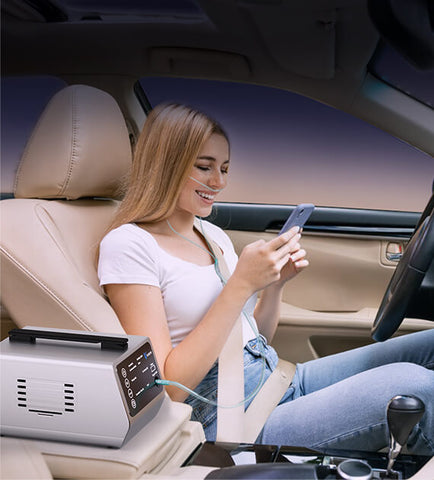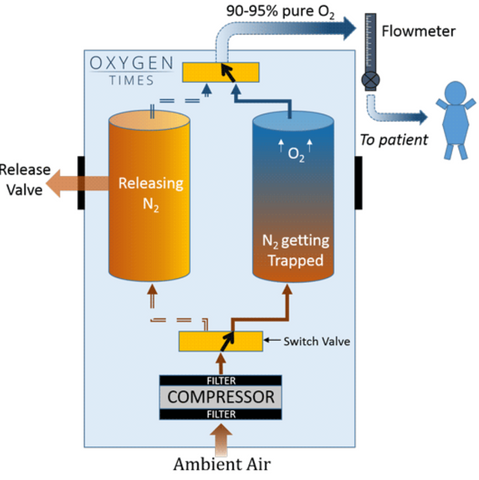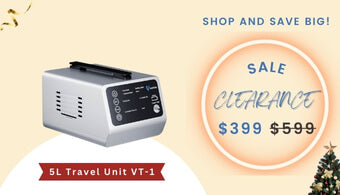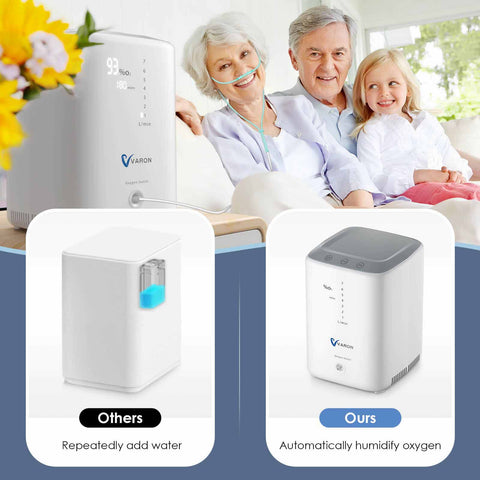For many individuals with respiratory conditions, oxygen therapy becomes an essential part of daily life. Oxygen machines, also known as oxygen concentrators, provide a safe and reliable way to deliver supplemental oxygen, enhancing your quality of life. But how does oxygen machine work?
This blog post dives into the inner workings of oxygen concentrators and explores the benefits of oxygen therapy.
Understanding Oxygen Therapy: How Does Oxygen Machine Work and Improve Your Breath of Life
Oxygen concentrators are devices that play a vital role in respiratory health management. Unlike compressed bulky oxygen tanks, which come pre-filled with concentrated oxygen, oxygen concentrators extract oxygen from the ambient air we breathe. This blog post dives into the world of oxygen therapy, explaining how does oxygen machine work, the conditions they treat, and the benefits of oxygen therapy.
Types of Oxygen Concentrators
There are two main categories of oxygen concentrators:
1. Home Oxygen Concentrators: Designed for continuous use in a residential setting, home oxygen concentrators are typically larger and more powerful than portable models. They provide a continuous flow of oxygen 24/7 and plug into a standard wall outlet (AC power). Some models may also include DC power for car use (with a separate inverter) and backup battery options for added peace of mind.
Oxygenvip's Home Oxygen Concentrators offer a variety of features to suit your needs, including:
-
VARON 1-7 L/Min Home Oxygen Concentrator 105W: This powerful model delivers adjustable oxygen flow rates (1-7 L/min) and operates continuously with minimal noise (≤48 dB).
-
1-7L/Min Adjustable Oxygen Concentrator Y-101W: Another adjustable flow model (1-7 L/min) with continuous operation and quiet operation (≤48 dB).
-
Best Selling 1-7L Home Oxygen Concentrator NT-04: Our most economical and affordable home oxygen concentrator provides adjustable flow (1-7 L/min) and boasts extended battery life (up to 72 hours) for backup power in case of outages.
Oxygenvip's Portable Oxygen Concentrators come in a variety of configurations to fit your needs:
- 3L/Min Portable Oxygen Concentrator NT-03: This lightweight option features pulse flow delivery and offers multiple timer settings for efficient battery use.
- 3L Continuous Flow Portable Oxygen Concentrator NT-05: This model provides continuous flow oxygen and extended battery life (up to 2 hours) with the option to purchase an additional battery for extended use.
- Best Selling 4.85lbs Lightweight 1-5L Portable Oxygen Concentrator NT-02: Our most portable concentrator offers adjustable pulse flow and impressive battery life (up to 4.85 hours) with the option to purchase an additional battery.
- 1-5L Pulse Flow Portable Oxygen Concentrator NT-01: A user-friendly option with built-in battery power for on-the-go oxygen therapy.
- 1-5L Versatile Continuous Flow Portable Oxygen Concentrator For Travel: This innovative model offers both pulse and continuous flow oxygen delivery, making it ideal for travel (optional accessories for AC power and external batteries sold separately).

Conditions Treated with Oxygen Concentrators
Some common conditions that may benefit from oxygen concentrators include:
- Chronic obstructive pulmonary disease (COPD)
- Emphysema
- Bronchitis
- Pulmonary fibrosis
- Congestive heart failure
- Sleep apnea
- High-altitude situations (for athletes and travelers)
How Does Oxygen Machine Work
Oxygen concentrators utilize a process called Pressure Swing Adsorption (PSA) to separate oxygen from the air. Here's a breakdown of the process:

- Air Intake: The machine draws in room air, which is about 20% oxygen and 80% nitrogen.
- Filtration: An air filter removes dust and other impurities from the incoming air.
- Compression: A compressor pressurizes the air, making the gas molecules easier to separate.
- Zeolite Beds: The compressed air flows through two chambers filled with zeolite crystals. These zeolite crystals have a higher affinity for nitrogen molecules, allowing oxygen to pass through more readily.
- Oxygen Collection: The separated oxygen accumulates in a reservoir within the concentrator.
- Delivery: The concentrated oxygen (usually 90-95% pure) is delivered to the user through a nasal cannula or mask.
- Regeneration: The zeolite beds take turns releasing the absorbed nitrogen back into the environment. This cyclical process ensures a continuous flow of concentrated oxygen for the user.

Usage Duration of Oxygen Concentrators
The usage duration of an oxygen concentrator depends on several factors, including:
- Make and Model: Different models have varying power outputs and efficiency levels.
- Oxygen Output: The higher the oxygen flow rate (measured in liters per minute or L/min), the shorter the battery life on portable models.
- Batteries: The number and capacity of batteries will significantly impact the total operating time away from a power outlet for portable concentrators.
Here's a general guideline for battery life:
- Single Battery: Typically provides 1-3 hours of operation on portable models.
- Double Battery: Can extend operation time to 3-6 hours on portable models.
- Plug-in Home Concentrators: Offer unlimited use as long as they are plugged into a standard AC power outlet.
Treatment Duration with Oxygen Concentrators
The duration of oxygen therapy depends on the underlying medical condition.
- Short-Term Use: Some individuals may only require oxygen therapy during periods of exacerbation (worsening) of their respiratory condition.
- Long-Term Use: For others, oxygen therapy may be needed continuously throughout the day and night.
Remember the frequency and oxygen output settings are based on your individual needs and always monitor your blood oxygen levels to ensure optimal treatment.
Benefits of Oxygen Therapy
Oxygen therapy offers a range of benefits for people with respiratory problems:
- Improved Breathing and Reduced Shortness of Breath: Increased oxygen levels in the bloodstream help alleviate shortness of breath and improve overall respiratory function.
- Increased Energy Levels and Better Sleep: Adequate oxygen supply can boost energy levels and promote better sleep quality, especially for those experiencing sleep apnea.
- Enhanced Cognitive Function: Studies suggest that oxygen therapy can improve cognitive function and alertness in individuals with chronic respiratory conditions.
- Unlimited Oxygen Supply with Continuous Power Source: Home concentrators plugged into a power outlet provide a continuous and reliable source of oxygen.
Disadvantages of Oxygen Concentrators
While oxygen concentrators are life-changing for many, a few potential drawbacks to consider include:
- Reliance on Power Source: Portable models require a reliable power source (battery or DC power) and backup options are crucial in case of outages. Oxygenvip offers extra batteries for each model sold separately. Some models even have 3 charging options** for added convenience: AC power, DC power, and replaceable batteries.
- Fire Hazard: Pure oxygen is highly flammable. It's important to avoid smoking or using open flames near an oxygen concentrator.
When to Call a Doctor
If you experience any of the following symptoms while using oxygen therapy, consult your doctor immediately:
- Symptoms of Oxygen Poisoning: Dizziness, confusion, nausea, facial twitching, chest pain (these can occur with excessively high oxygen levels).
- Symptoms of Hypoxia (Low Blood Oxygen): Restlessness, blue-tinged skin (cyanosis), slow heart rate, confusion (these can occur with inadequate oxygen levels).
Pulse Oximeters: These fingertip devices can be helpful for monitoring blood oxygen levels at home. Regular maintenance checks on your oxygen concentrator are also essential to ensure optimal performance.
Guide Before Purchasing an Oxygen Concentrator
Several factors to consider when purchasing an oxygen concentrator include:
- Cost: Home oxygen concentrators are typically more expensive than portable oxygen concentrator models.
- Warranty and Repairs: Choose a reliable brand with a good warranty and readily available repair services.
- Your Needs: Consider factors like portability, noise level, oxygen flow requirements, and battery life.
Conclusion
Oxygen concentrators are valuable tools for managing respiratory conditions and improving quality of life. Understanding how they work and the benefits they offer can empower you to make informed decisions about your health.
At Oxygenvip, we understand the importance of maintaining an active lifestyle and managing respiratory health. That's why we offer a wide range of home and portable oxygen concentrators to suit your specific needs and preferences. All our concentrators are:
- Lightweight and Portable (Portable Models): Our portable oxygen concentrators are designed for easy portability, allowing you to maintain your daily activities and travel with confidence.
- Quiet Operation: Enjoy discreet oxygen therapy without worrying about disruptive noise.
- Easy to Use: Our oxygen concentrators come with user-friendly controls and clear instructions, making them simple to operate.
- Reliable: We use high-quality materials and construction to ensure the long-lasting performance of our oxygen concentrators.
We also offer a variety of accessories to enhance your oxygen therapy experience, including:
- Nasal Cannulas: These comfortable tubes deliver oxygen directly to your nostrils.
- Oxygen Tubing: Connects the concentrator to your nasal cannula.
- Carrying Cases: Protect your portable concentrator during transport.
- Replacement Batteries: Extend the operating time of your portable concentrator.
Ready to breathe easier and live a more active life?
At Oxygenvip, we are committed to providing exceptional customer service and support. We offer a wide range of high-quality, reliable oxygen concentrators to suit your specific needs and preferences. Browse our selection online today or contact our knowledgeable customer service team to discuss your options. We're committed to providing exceptional service and support to help you achieve optimal respiratory health.
Take control of your breath. Take control of your life. Visit Oxygenvip today!


















